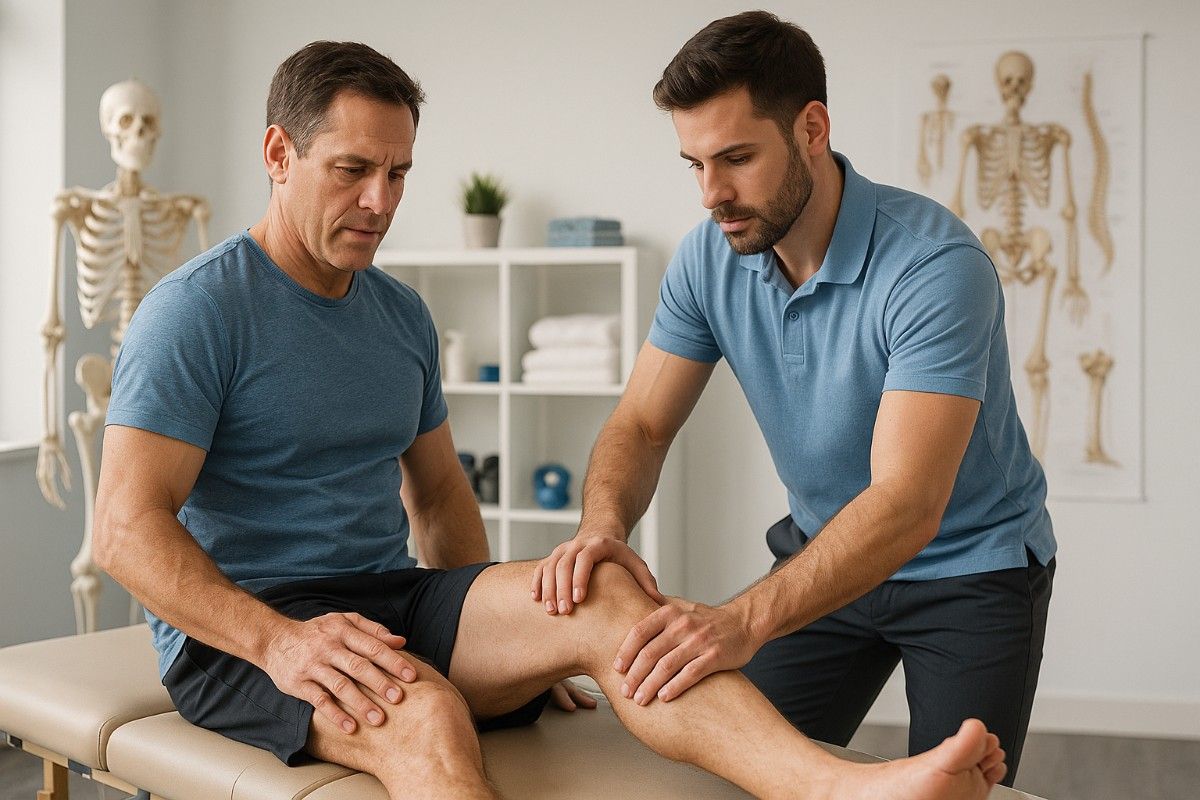Orthopaedic physiotherapy functions as a specialized area of physical therapy which evaluates and treats musculoskeletal injuries and disorders through rehabilitation methods. The musculoskeletal system comprises bones, joints, ligaments, muscles, and tendons. Orthopaedic physiotherapy treatments include acute sports injuries and postsurgical rehabilitation alongside chronic pain disorders such as arthritis and scoliosis.
Orthopaedic physiotherapy serves as an essential treatment approach to improve functional abilities and life quality for people spanning all age groups who experience mobility restrictions and musculoskeletal disorders. The increase in sedentary lifestyles along with trauma and age-related conditions has made Orthopaedic physiotherapists essential for both preventive measures and rehabilitation treatment.
Principles of Orthopaedic Physiotherapy
1. Assessment: Detailed evaluation stands as the essential foundation for any physiotherapy intervention. A comprehensive evaluation to diagnose dysfunction requires patient history analysis along with physical examinations and ROM tests and gait analysis as well as muscle strength tests and special Orthopaedic tests.
2. Goal Setting: Therapists establish immediate and distant objectives which target pain relief and improved mobility alongside muscle strengthening and activity restoration following assessment results.
3. EvidenceBased Treatment: Therapists choose treatment methods that reflect the latest scientific evidence and customize them to fit each patient’s unique requirements.
4. Patient Education: A fundamental aspect of Orthopaedic physiotherapy involves educating patients about their medical condition and teaching them selfmanagement techniques alongside their treatment plans.
Common Conditions Treated
Orthopaedic physiotherapists manage diverse medical conditions such as:
Fractures and postfracture stiffness
Postoperative rehabilitation activities that follow procedures like knee or hip replacement operations.
Osteoarthritis and rheumatoid arthritis
Low back pain and sciatica
Sports injuries (ligament tears, muscle strains)
Neck pain and cervical spondylosis
Frozen shoulder (adhesive capsulitis)
Tendonitis and bursitis
Scoliosis and postural issues
Carpal tunnel syndrome
Role of Orthopaedic Physiotherapy
Orthopaedic physiotherapy plays a vital role in managing musculoskeletal conditions by fulfilling various essential roles.
1. Pain Management
Patients commonly seek physiotherapy services to address both acute and chronic pain conditions. Medical professionals rely on manual therapy and electrotherapy methods including TENS, IFT, ultrasound along with dry needling and therapeutic taping to treat pain effectively without medication dependence.
2. Restoring Mobility and Function
Therapists use tailored rangeofmotion exercises together with mobilization and stretching techniques to recover joint and muscle movement which patients lose from injury, immobility, or surgery.
3. Strengthening and Conditioning
Patients use strengthening exercises with resistance bands, weights or bodyweight movements to rebuild strength after injuries or surgeries. These exercises support muscle balance restoration while reducing the risk of future injuries.
4. PostOperative Rehabilitation
Physiotherapists guide patients through graded rehabilitation protocols to help them restore mobility, strength, and function following Orthopaedic procedures like ACL reconstruction, joint replacement surgeries, or spinal surgeries.
5. Preventing Further Injury
Orthopaedic physiotherapists treat existing conditions while addressing biomechanical problems and teaching patients about proper posture and ergonomics to stop future issues.
6. Enhancing Performance in Athletes
Orthopaedic physiotherapists serve as essential specialists in both rehabilitating athletes after sports injuries and enhancing their performance while reducing the risk of future injuries. Physiotherapy programs replicate sportspecific movements to allow athletes to safely resume their sporting activities.
Scope of Orthopaedic Physiotherapy
Orthopaedic physiotherapy maintains a wide scope that continues to grow as it applies to multiple areas such as hospital care, sports medicine, wellness programs, geriatric treatment, and occupational health support. Some key areas of its scope include:
1. Clinical Practice in Hospitals and Clinics
Orthopaedic physiotherapists serve as essential hospital staff members who handle trauma cases and help with pre and postoperative rehabilitation as well as emergency Orthopaedic issues.
2. Private Practice and Outpatient Settings
Physiotherapists function as independent practitioners or work within multispecialty clinics to deliver personalized treatment for Orthopaedic conditions.
3. Sports and Fitness Centers
The expertise of sports physiotherapists in injury prevention, recovery and returntosport training makes them indispensable in sports academies and fitness clubs.
4. Geriatric Care
Older adults encounter multiple Orthopaedic problems including arthritis along with osteoporosis and heightened risk of falling. Physiotherapists play a crucial role in helping elderly patients maintain mobility and independence while also working to lower fracture risks.
5. Home Care and Telerehabilitation
Digital health platforms now enable remote delivery of physiotherapy services. Telerehabilitation alongside home visits enables patients who have limited mobility or are recovering from surgery to access medical care while staying at home.
6. Research and Academia
Physiotherapists make important research contributions in fields like biomechanics, pain science, and rehabilitation technology. Physiotherapists have opportunities to teach at academic institutions where they educate upcoming professionals.
7. Industrial and Occupational Health
Physiotherapists prevent workplace musculoskeletal disorders by performing ergonomic assessments and workplace modifications while implementing preventive exercise programs.
Advanced Techniques and Tools in Orthopaedic Physiotherapy
Orthopaedic physiotherapy now benefits from multiple sophisticated tools and methods which improve patient recovery results.
Cupping Therapy
Kinesio Taping
Dry Needling
Laser and Shockwave Therapy
InstrumentAssisted Soft Tissue Mobilization (IASTM)
Virtual Reality (VR)based rehabilitation
Wearable rehabilitation technology
The new tools enable physiotherapists to deliver precise treatment plans that achieve effective results and accelerate patient recovery.
Orthopaedic physiotherapy remains a fundamental component of contemporary healthcare because it connects patients from injury to complete recovery. This field provides treatment for musculoskeletal conditions while also focusing on preventive measures and comprehensive health education. The range of physiotherapy practice expands constantly as it becomes more critical for sports medicine, elderly care, management of sedentary lifestyle diseases, and postoperative rehabilitation.
Orthopaedic physiotherapists can take charge of musculoskeletal health’s future as technological progress continues alongside growing public understanding because they provide patients with recovery pathways that lead to improved quality of life.
– Dr. Vaibhav Dave, Head of Department
Department of Physiotherapy, Madhav University

